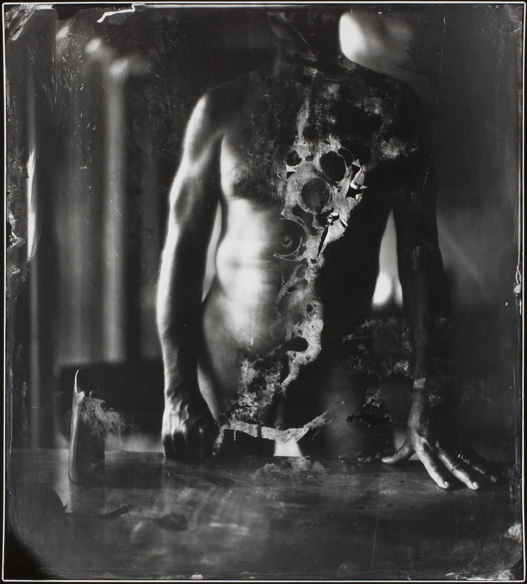Sally Mann: The Flesh and The Spirit
Text by John Ravenal, David Levi Strauss, Anne Wilkes Tucker.
Published by Aperture
Reviewed by Daniel W. Coburn
To truly appreciate the magnitude and importance of the work included in Sally Mann: The Flesh and the Spirit, one must begin to understand and empathize with the plight of the artist. Success cannot be measured by the impact of a single photograph or even a series of photographs, but by the emotional and intellectual transformation that takes place in the mind of the creator through the process of making work. Sally Mann grapples with the universal themes of love, loss and mortality that simultaneously enrich and plague the human condition. The beauty and power of Mann’s lifelong exploration of these topics lies in her ability to employ the art of photography as a psychological conduit. It is a channel through which she powerfully and effectively communicates her personal discoveries to the viewer. Her photographs celebrate a human existence that is both tragic and beautiful.
Mann’s recent photographs have all but abandoned the formalism that was once present in her seminal body of work Immediate Family. This doesn’t make it less compelling or poignant, but one must make a conscious effort to understand the context in which the work was created to fully appreciate what she is trying to express. This 200 page catalog, which was designed to accompany an exhibit of Mann's work at the Virginia Museum of Fine Art, does an exceptional job of outlining the conceptual groundwork behind the artist's creative process. The book presents a survey of Mann's work that employs the body as it's central theme. Some of the images are familiar and some of them exhibited for the first time at the VMFA. The photographs are not presented in chronological order. Without the descriptive text, written by curator John B. Ravenal, one might wonder if Mann's message has somehow taken a backseat to her interest in the antiquated processes she uses to make her most recent photos.
The first plates presented in the book are a series of self-portraits that she made using the ambrotype process. The images are haunting and pained, presenting frontal views of Mann that are often blurred or distorted due to long exposure times. The flaws and distressing artifacts of the process are embraced by Mann to communicate a sense of despair, pain, or loss. These images mark a period of introspection for the photographer. Her work takes an autobiographical turn in these pieces that force the viewer to empathize with a person that is struggling emotionally and physically. Several selections from her work Family Color are included. These seem to be an extension of the Immediate Family series, wielding a similar haunting and lyrical presence, but are reproduced with the additional dimension of color. The book contains other familiar work including the large-scale portraits of her children in What Remains, and challenging images of decomposing human bodies in Matter Lent. Mann exploits the artifacts of the Wet-Plate Collodian process in both of these series’ in an effort to communicate about the fleeting nature of human life and material existence. In Proud Flesh, some of the most recent work featured in this monograph, the artist points her camera in the direction of her life-long partner Larry Mann. In an effort to address sexuality and the powerful bond of love, she elevates the commonplace to monumental status by creating a fragmented, empathetic portrait of her husband. The ethereal, romantic aesthetic harkens back to the approach of early Pictorialists such as Julia Margaret Cameron. Thin Skin features some of the most abstract images that Mann has created to date. She makes closely-cropped photographs of her upper torso, at times completely abandoning the notion of representation.
When Sally Mann notoriously achieved critical acclaim and success in the early nineties with Immediate Family, she set an important and challenging precedent. Inevitably, every photograph that she produced afterward would be compared to this previous work. The text and imagery presented in Sally Mann: The Flesh and The Spirit challenges the notion that an artist can or should be judged on the success of a single photograph or series. In many ways it suggests that these images cannot be categorized or separated. It insinuates that each photograph is intimately tied to the next, and that a single print cannot be completely understood or reconciled outside of this greater context. Mann’s work has become a metaphor for life itself. The transition that occurs from the beautiful, pristine, and technically brilliant images of Immediate Family to the ambiguous, degraded, irreconcilable photographs of Thin Skin describes and elaborates upon the psychological and physical deterioration that occurs over the course of life.
Those that have an up-to-date collection of Sally Mann monographs may want to consider the fact that this book is a survey of work completed over the past 40 years. Many images that appeared in previous volumes are duplicated in this one. However, this book provides an insight, perspective, and context for the work that is unprecedented. The supplemental essays written by David Lee Strauss and Anne Wilkes Tucker will prove to be exciting and insightful to those who appreciate the endeavors of this provocative artist. It is for this reason that I highly recommend Sally Mann: The Flesh and the Spirit for inclusion in your library.
To purchase the book, click here.
Daniel W. Coburn is a photographer and graduate student at the University of New Mexico.
To view Daniel's photography, please visit his website. Daniel was also featured in Fraction Issue 20.
(editor's note: Daniel has a print in the Fraction Holiday Print Sale)



